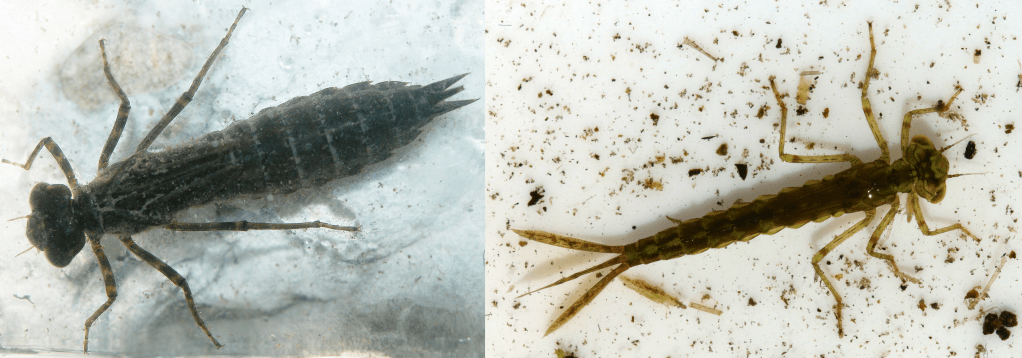Listen to Episode 181 on PodBean, YouTube, Spotify, or wherever you listen to your favorite podcasts!
They’re among the world’s most skilled fliers, most efficient predators, and most ancient lineages. This episode, we discuss the evolution and lifestyles of the living and extinct members and cousins of Dragonflies.
In the news
Study analyzes evolution and extinction of crocs in different habitats
Young tyrannosaur preserved with last meals in its stomach
Using skull anatomy to interpret ancient elephant trunks
The oldest fossil mosquito is a blood-sucking male
Order Odonata
The insect Order Odonata (odonates) includes two major living subgroups: dragonflies (Anisoptera) and damselflies (Zygoptera). (Also there’s a secret tiny third group)
Dragonflies and damselflies are exceptional insects for several reasons. For one, they’re extremely diverse, with over 6,000 living species all over the world. For another, they’re excellent predators, often among the most influential predatory animals in both the air and water, as adults and nymphs, respectively. And finally, they are famously adept fliers; their wings are highly adapted for efficient flight, and their musculature allows them to control the movement of each wing individually, which together gives them the ability to fly in all directions, to hover, and to execute incredible aerial maneuvers. In fact, many odonate species do almost everything – from hunting to mating – on the wing.

Compared with damselflies, dragonflies typically have heavier bodies, more closely-spaced eyes, and lack the ability to angle the wings parallel to the body at rest.
Top: Small pincertail dragonfly (Onychogomphus forcipatus). Image by Charles J. Sharp, CC BY-SA 4.0
Bottom: Common bluetail damselfly (Ischnura senegalensis). Image by Laitche, Public Domain

Nymphs have specialized mouthparts that can rapidly extend forward to grab prey.
Damselfly nymphs have external gills that double as tail fins, while dragonfly nymphs don’t have that and instead can use jet propulsion from their butts.
Left: Emperor dragonfly (Anax imperator) nymph. Image by Totodu74, Public Domain
Right: Blue-tailed damselfly (Ischnura elegans) nymph. Image by Charles J. Sharp, CC BY-SA 3.0
Odonates are an early branch of winged insects, within a group called Palaeoptera (alongside mayflies). Unlike most winged insects, dragonflies and damselflies cannot fold their wings down against their abdomen. Also unlike most winged insects, odonates’ wing muscles directly control the movement of each wing (most insects’ wing muscles distort the shape of the thorax to make the wings move); this means odonate wings flap more slowly, but it also allows them to perform complex patterns of wing movement, part of what gives them their incredible flight capabilities.
Odonatoptera and the Fossil Record
Odonata belongs to a broader group called Odonatoptera, which includes true dragonflies and damselflies and a huge diversity of their extinct cousins. The oldest known members of this lineage are over 320 million years old, among the oldest known insects, and by then they were already highly specialized aerial predators.
For tens of millions of years in the Late Paleozoic, dragonfly-cousins were the only major group of flying predators. From that time onward, even after vertebrate fliers evolved in the Late Triassic, Earth’s habitats have always been home to diverse and efficient odonate predators. For almost as long as there have been terrestrial ecosystems, dragonflies and their kin have been hunting in them.
Odonates and their cousins have a surprisingly rich fossil record, with thousands of known specimens representing hundreds of extinct species, among the most complete fossil record of insects. Unusually for insects, this fossil record mostly consists of compression fossils preserved between layers of fine sediment, while fossils in amber are comparatively rare.

Bottom: Partial dragonfly fossil in amber. Image by Oregon State University, CC BY-SA 2.0
During the Late Paleozoic, there were many successful lineages of odonatopterans. By far the most famous belong to a group called Meganeuridae, within the larger group Meganisoptera, also called griffenflies. These were a successful and diverse group with a wide range of sizes and habitats. They also include the largest insects of all time.
The two commonly-cited largest members are Meganeura from Late Carboniferous Europe and Meganeuropsis from Early Permian North America. Both had wingspans up to 70cm (28in) – for comparison, the largest living odonates have wingspans up to 20cm (8in). These giant griffenflies, like their living cousins, were aerial predators as adults and aquatic predators as nymphs. Exactly why they were able to grow so large isn’t fully understood; proposed explanations include: high oxygen levels; high temperatures; abundant food; and a lack of competition or threat from other aerial predators.

Bottom: Reconstruction of the griffenfly Meganeurites gracilipes. Image from Nel et al 2018
Griffenflies and most other ancient lineages of odonatopterans went extinct during the Permian and Triassic. By then, the earliest of Odonata had evolved and diversified into true dragonflies, true damselflies, and other now-extinct groups.
Learn more
Videos:
Dragonfly in slow motion
Dragonfly hunting
Dragonflies flying backward
Dragonfly nymphs hunting
Introduction to the Odonata
World Dragonfly Association – Lots of resources for more info
The Dragonfly Website – Even more info
Dragonflies Embark on an Epic, Multi-Generational Migration Each Year
Flight of the dragonflies and damselflies (technical, open access)
Palaeozoic giant dragonflies were hawker predators (technical, open access)
The Odonatoptera: a clade that contains 99% of Odonata fossil diversity (technical, paywall)
__
If you enjoyed this topic and want more like it, check out these related episodes:
- Episode 99 – Evolution of Insects
- Episode 144 – Evolutionary Gigantism and Dwarfism
- Episode 149 – Ants
We also invite you to follow us on Twitter, Facebook, or Instagram, buy merch at our Zazzle store, join our Discord server, or consider supporting us with a one-time PayPal donation or on Patreon to get bonus recordings and other goodies!
Please feel free to contact us with comments, questions, or topic suggestions, and to rate and review us on iTunes.